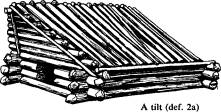Quick links
tilt
DCHP-1 (pre-1967)
Entry from the DCHP-1 (pre-1967)
This entry may contain outdated or offensive information, terms, and examples.
1an. — Esp. Lab
a temporary shelter of canvas, sealskins, etc.; tent.
Quotations
1753
[Entering the Harbour they saw Shallops built after the Newfoundland Manner, at Anchor, with Buoys and Cables, a Mast, a square Yard athwart, with a Sail bent, a tilt made of seal Skins abaft.]
1771
[I made] a tilt with some seal skins which I borrowed. . . .
1891
On every square rod of flat rock on the steep sides of the harbor was a Newfoundlander's "tilt" or summer house.
1907
When the black bear enters a tilt or wigwam, it opens and scatters everything within, whilst it has a curious habit of never departing by the way of entry, preferring to scrape a hole in the side of the shelter by way of exit.
1942
Some had canvas tilts, and in these were the regiment's women and children, a mixed lot like the men.
1bn. — West, Hist.
the canvas covering of a prairie schooner.
See: tilted wagon
Quotations
1859
We set out in a . . . waggon and four . . . a stout canvas tilt and curtains protecting us around and overhead.
1943
Mrs. Fraser was still in the wagon . . . craning from the hooped open front of the tilt to see him. . . .
2an. — Esp. Lab
a log hut or cabin used by fishermen or trappers and characterized by a sloping roof that overhangs the door.
See: tilt-back
Quotations
1770
In our return we found two old furriers' tilts, and snow death-falls; which appeared to be of Canadian construction.
1958
In a fisherman's "tilt" or hut, McKay's observant eye noticed a piece of bright yellow stone on the mantelshelf.
1966
The tilt was a trapper's winter quarters and the slanted gable was a protection against heavy snowfall, helping prevent the entrance becoming snowbound.
2bn.
any simple dwelling, especially one made of wood.
Quotations
1842
[He] killed a cow at Broad Cove Gastors, with several sheep, goats, and fowls, having been repeatedly seen by the poor people, from the doors of their tilts, in the woods. . . .
1849
The planters, as they are designated, live in houses which they call "tilts," varying in shape and size according to the circumstances of the owner.
1905
They live in little "tilts"--log huts of one large square room, with 'bunks' at each end for the women-folk, and a 'cockloft' above for the men and lads.
Images
